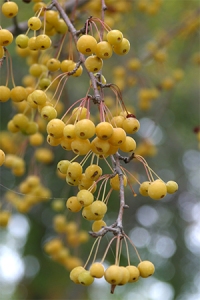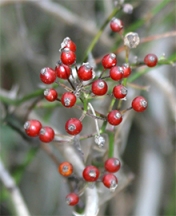I love trees and shrubs that produce berries – especially the ones that hold their berries into the winter. Berries brighten the landscape and provide a splash of color at an otherwise drab time of the year.

The bright red berries of Ilex verticillata brighten the winter landscape and provide a nutritious snack for the birds.
But these berries offer more than beauty in the landscape. They supply a natural source of food for birds and other wildlife through much of the winter and many also provide them with some great winter “hiding places”.
One of the secrets to creating a wildlife and bird-friendly landscape is to plant a diversity of trees and shrubs that will provide food and shelter for a wide variety of furred and feathered critters. There are loads of beautiful berry producers that feed the critters and also make wonderful landscape plants. I’ve written quite a lot about Beautyberry (Callicarpa) and Winterberry holly (Ilex verticillata) but there are many others out there for the planting!
One of the best trees to plant for wildlife is the crabapple. The fruit lasts well into the winter and provides an excellent source of food for many different wild birds including waxwings, bluebirds, cardinals, grosbeaks, wrens, robins, and mockingbirds. According to Andre, the small fruited varieties (fruit less than 3/4″) are preferred by birds. The squirrels, chipmunks, and deer enjoy the larger crabapples especially after they fall from the tree.
Dogwoods, both the native (Cornus florida) and the Kousa dogwood (Cornus kousa), are beautiful in the landscape especially in the spring and they produce wonderful berries/fruit that the birds love. The fruit of the Kousa dogwood is fleshy; more like a cherry than a berry and the birds just devour these!
Common Hackberry (Celtis occidentalis) is a very hardy deciduous tree that provides food for birds and wildlife. The fruit ripens in the late summer and persists into winter. Wild turkeys, woodpeckers, waxwings and even little mice find the fruit of hackberry irresistible!
There are many evergreens that provide food for birds through the winter. Eastern Red Cedar (Juniperus virginiana) is a beautiful native cedar that produces attractive blue berries that are a favorite of Cedar Waxwings and many other birds.
The red berries of the American Holly (Ilex opaca) mature in October and persist on the tree well into winter – at least until the birds eat them all! These evergreen hollies are a wonderful addition to the garden and provide great nesting sites for many species of birds including mourning doves and robins.

Ilex opaca ‘Merry Christmas’ is aptly named with its reliable profusion of red berries in fall and winter.
Berry laden holly boughs can also be cut in December for use in holiday arrangements – an added bonus!
Many ornamental species of Sumac (Rhus) and Viburnum produce berries that ripen in late summer or early fall and remain on the shrubs into the winter. These shrubs attract a variety of different birds to the garden including flickers, woodpeckers, cardinals, robins, bluebirds, sparrows, and grosbeaks.
There are several beautiful cultivars of Scarlet Firethorn (Pyracantha coccinea) that have spectacular berries in shades of red, orange, and yellow. These shrubs can be used as a specimen in the garden, as an informal hedge, or espaliered on a wall or trellis. In addition to feeding on the berries, many birds also like to nest in these shrubs because the branches are covered with sharp thorns which provide protection from predators.

A bull moose enjoys a snack of mountainash berries in the middle of Anchorage, Alaska. Special thanks to Bill McDonald for the photo.
Mountainash (Sorbus spp.) produces spectacular clusters of brilliant red or orange fruit that is a favorite of many different birds and even larger critters. My brother-in-law sent me some photos of a large bull moose noshing on the berries of Mountainash right outside his office in Anchorage, Alaska! “He doesn’t come everyday,” Bill said, “but when the snow gets thick and it is harder to forage in the woods, he comes into town for a snack.”
How cool is that to see outside your office window – and in the middle of the city. Never a dull moment!
Rugosa Rose (Rosa rugosa) and many varieties of honeysuckle (Lonicera spp.) also produce loads of rose hips and berries to feed the birds and other wildlife during the winter.
Consider adding some of these wonderful trees and shrubs to your gardens next spring. You will not only be rewarded with a beautiful and colorful landscape but your wildlife friends will love you forever!
Until next time – Happy Gardening!
P.S. – Don’t forget to provide your feathered friends with a source of fresh, unfrozen water over the winter!





